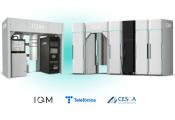‘Significant Strides’ for Center for Quantum Dynamics on Modular Quantum Devices
There is currently a huge gap between the problems for which a quantum computer could be useful in chemistry – including studies of quantum reaction dynamics and spectroscopy – and what can actually be simulated today with quantum computers, even with the largest and most impressive qubit platforms from IBM, Google, or Rigetti. The challenge is that most well-known quantum computing (QC) algorithms have hardware requirements and circuit depths that far exceed the current scale by several orders of magnitude.
Closing the so-called ‘QC gap’ is essential to make QC technology finally available to chemistry, beyond the rather simple proof-of-concept applications that so far have been developed. One approach is to find platforms for efficient realizations at the hardware level of the molecular problems of interest, and that is the vision of the Center for Quantum Dynamics on Modular Quantum Devices.
“The Center is making significant strides in the realm of quantum simulations for complex chemical systems, utilizing cutting-edge programmable Kerr-cat and conventional quantum computing platforms,” said Victor S. Batista, the John Gamble Kirkwood Professor of Chemistry and director of the Center.
“This pioneering research aims to showcase the exceptional potential of bosonic modular devices in the quantum simulation of chemical dynamics,” he explains. “By focusing on the creation of modular 3D circuit quantum electrodynamics (cQED) platforms, and the formulation of novel algorithms for these systems, the Center is poised to offer transformative approaches to advance our understanding of photoinduced quantum reaction dynamics, vibronic interactions, quantum chemical dynamics and quantum machine learning methods.”




































